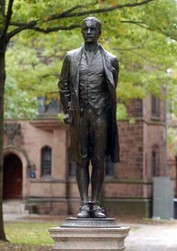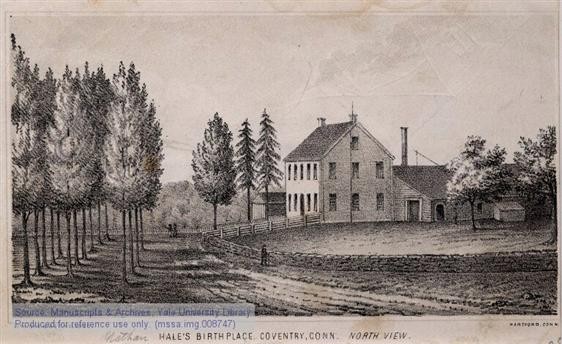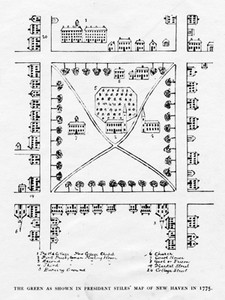Nathan Hale Statue, Yale
Introduction
Text-to-speech Audio
This bronze statue commemorating famous patriot Nathan Hale stands in Yale's Old Campus, next to Connecticut Hall, Hale's former dormitory. After graduating from Yale in 1773, he worked as a teacher and then a soldier during the American Revolution. He is famous for his death at the hands of British captors and his (putative) final words, inscribed at the base of the statue: "I only regret that I have but one life to lose for my country." The statue was created by Bela Lyon Pratt in 1913 and donated by alumni to the university.
Images
Hale stands on Old Campus, close to his old dorm (Yale University Visitor Center)

Hale's birthplace in Coventry, CT (Manuscripts & Archives, Yale University)

Map c. 1775 by Rev. Ezra Stiles, showing the New Haven Green (Manuscripts & Archives, Yale University)

Backstory and Context
Text-to-speech Audio
Nathan Hale was born on a farm in Coventry in 1755. He and his brother Enoch were tutored in Latin and Greek by a local minister and Yale graduate, Rev. Joseph Huntington. The brothers arrived at Yale together in 1769, when Enoch was 16, Nathan only 14. They were two of around 100 young men in the entire college. After his graduation, Nathan taught first in East Haddam and then in New London, Connecticut, which he preferred. During this time, he held early morning summer classes for women, in addition to the customary course offerings for men.
Hale enlisted as a lieutenant in July 1775. He became a captain in January 1776 and in September took on his short-lived role as a spy. He was captured by the British and executed the same month.
Yale's Nathan Hale statue is one of several unveiled over the decades. In 1893, a statue commissioned by the Sons of the Revolution and sculpted by Frederick MacMonnies was dedicated in New York's City Hall Park. Twenty years later, Bela Lyon Pratt's Hale statue was unveiled on Yale's Old Campus. A copy of this statue stands at CIA headquarters in Virginia. Despite campus legends that claim that the CIA attempted to steal Yale's statue of Hale, Professor Emeritus Gaddis Smith's comprehensive history of Yale sets the record straight- the CIA asked permission to create a close replica of the statue. Another Nathan Hale statue, created by Karl Gerhardt, exists in the Connecticut State Capitol in Hartford. In Gerhardt's vision, Hale is unbound, whereas in Pratt's statue Hale's feet are tied, and he appears in the moments before his execution.
Hale enlisted as a lieutenant in July 1775. He became a captain in January 1776 and in September took on his short-lived role as a spy. He was captured by the British and executed the same month.
Yale's Nathan Hale statue is one of several unveiled over the decades. In 1893, a statue commissioned by the Sons of the Revolution and sculpted by Frederick MacMonnies was dedicated in New York's City Hall Park. Twenty years later, Bela Lyon Pratt's Hale statue was unveiled on Yale's Old Campus. A copy of this statue stands at CIA headquarters in Virginia. Despite campus legends that claim that the CIA attempted to steal Yale's statue of Hale, Professor Emeritus Gaddis Smith's comprehensive history of Yale sets the record straight- the CIA asked permission to create a close replica of the statue. Another Nathan Hale statue, created by Karl Gerhardt, exists in the Connecticut State Capitol in Hartford. In Gerhardt's vision, Hale is unbound, whereas in Pratt's statue Hale's feet are tied, and he appears in the moments before his execution.
Sources
Mooney, Richard, curator. "Nathan Hale: Yale 1773." Yale University Library. May 21, 2005. Accessed May 21, 2017. http://www.library.yale.edu/mssa/exhibits/hale/index.html.
Pelland, Dave. "Nathan Hale Statue, New Haven." Connecticut Monuments. March 26, 2012. Accessed May 16, 2017. http://ctmonuments.net/2012/03/nathan-hale-statue-new-haven/.
"Public Art at Yale: Nathan Hale, 1913." Yale University Visitor Center. Accessed May 16, 2017. http://visitorcenter.yale.edu/tours/public-art-yale.
Pelland, Dave. "Nathan Hale Statue, New Haven." Connecticut Monuments. March 26, 2012. Accessed May 16, 2017. http://ctmonuments.net/2012/03/nathan-hale-statue-new-haven/.
"Public Art at Yale: Nathan Hale, 1913." Yale University Visitor Center. Accessed May 16, 2017. http://visitorcenter.yale.edu/tours/public-art-yale.
